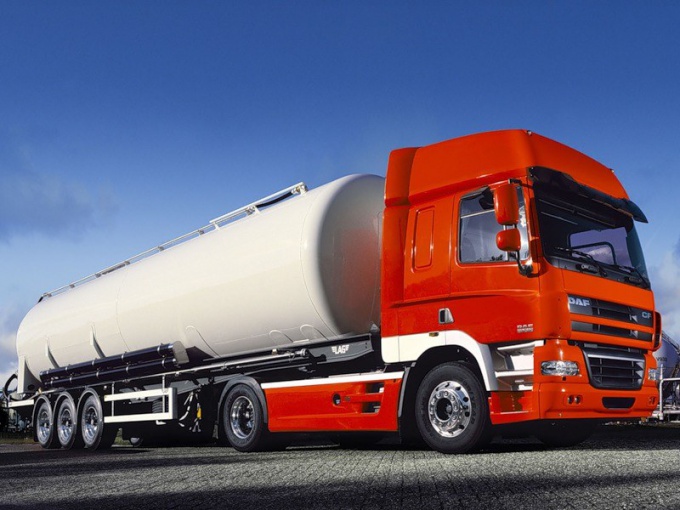Despite the potential threat, the statistics show that dangerous goods are the most frequently transported type of cargo. Transporterowych them on planes and trains. But most often for transportation by vehicles. If you consider what the unstable situation on the roads of Russia, you can imagine how thoroughly and literally must comply with the rules of carriage.
Before forming train, it is necessary to classify the transported product. First, relevant documents will be needed in case of an unscheduled inspection of the car by the traffic police. Second, it will help to more accurately determine the conditions of carriage. So, goods are divided according to their physical and chemical properties, and types and severity. After all, carried inert weapon is less dangerous than liquefied gas in the tank. All must be agreed with the standards. Experts identify 9 potentially dangerous classes of goods which, in turn, can successfully be classified by another category. The list includes:
- Class 1: explosive substances that can cause fire in the explosion (mainly include various pyrotechnic materials and products);
- Class 2: szhizhennye gases, including aerosols;
- Class 3: flammable liquids and slurries having flammable vapor;
- Class 4: flammable materials that can ignite from an external heat source (this does not include those classified as explosives);
- Class 5: substances that cause oxidation, is able to release oxygen and support combustion, as well as those at the creation of favorable conditions for them can spontaneously ignite and explode;
- Class 6: toxic substances and various products of an infectious nature (able to cause death and mass infection of the population);
- Class 7: radioactive substances;
- 8th grade: caustic and corrosive substances;
- Class 9 - substances with a reduced strap danger when transporting, which can not be attributed fully to either of the above types.
Naturally, that carry such dangerous materials and substance the first comer the man in the street won't allow it. Therefore, such transport is usually involved in the whole company who have successfully passed the licensing with the appropriate authorities. And it is in their interest to ensure that the license period has not ended. Otherwise, if the check, the company offers a very big trouble.
To transport dangerous goods on a particular route, you must also go through the whole procedure for obtaining all necessary permits and approvals. For example, if you are going to send dangerous goods by road (or want to be a burden), it is necessary to obtain a permit for the transportation of bodies of internal Affairs at the location of the cargo. For this you need to apply to the police Department at the place of acceptance of cargo with the following information:
- name of goods;
- quantity or volume;
- transportation route;
- who is the responsible person for the carriage;
- the number of persons accompanying and guarding the cargo.
All this information is necessary to support corresponding documents: emergency card information system risk (this is usually placed on the number of the car), the routesheet (and definitely agreed with the shipper and consignee), evidence of admission of the vehicle to movement on the road network of the country and the resolution of the car on the transport of dangerous goods (because not every car is meant for such purposes). Mark must be affixed on the router. Also note that in the transport of nuclear materials, will have to obtain additional permission from Gosatomnadzor.
It is a mistake to think that a truck with dangerous cargo can easily follow all the major highways of the country. In fact, for such a transport route is selected individually and must meet certain requirements and standards. The development of optimal ways of movement must deal with the traffic police.
Among the requirements that are required for compliance include the following factors. Near the route of the road transport of dangerous goods must not be any large industrial facilities. In addition, the carrier is unable to cross areas of mass rest of people, protected area and other protected areas. Also, all along the route, consideration must be given to rest areas, driver and petrol stations. It should be remembered that the route cannot pass through large settlements. If the necessity of entering the city is saved, the route must be laid away from places of a mass congestion of the people - the places of entertainment, cultural, educational, academic, medical etc.
To reconcile, you must submit a fully itemized itinerary to the security of the road, at least 10 days prior to commencement of carriage. In the case of changed circumstances, or itinerary needs to be adjusted, it is necessary to coordinate the new project with the organs of internal Affairs. The permit is issued in three copies, one of which is the traffic police, the other by the transport operator, the third - is responsible for the load entity.
All loading and unloading is very strictly regulated. The control must implement the man who was chosen by the responsible person. In the absence of such - the representative of the consignor and the driver of the motor vehicle. To load the car to its full capacity - the volume must be prescribed in special instructions for the trip. Must comply with all security measures - lack of tremors, jerks, shocks when the load is moving on the car. Should be avoided and those operations that can cause sparks. The engine of the vehicle at the time of loading or unloading should be off. In addition, it should be remembered that to accept or deliver dangerous goods only on special posts. Loading or unloading of hazardous substances is prohibited in the presence of any damage of the container or vehicle.
In addition to the rules of loading and unloading, strictly regulated and the rules of the transport itself. For example, the driver must observe the speed limit, which for him personally was determined by internal Affairs bodies, taking into account the area of transportation and road conditions. Transportation to ensure the safety of both cargo and the environment.
Parking for the rest of the drivers in settlements is prohibited. As a rule, to determine special places which are located not closer than 200 metres from places of a congestion of people. When you stop to rest, the driver must put the car on the Parking brake. If the terrain is marked draft, must also be placed under the wheel chocks.
Must be a stock of fuel for a distance of at least 500 km away. If you expect traffic on the route by more than this distance, it is necessary to equip the vehicle with additional fuel tank (this procedure must be coordinated with the traffic police).
If you follow all the rules of carriage and pass through all matching, even the carriage of dangerous goods will be reasonably safe and not so difficult.
Classification of goods according to their degree of danger
Before forming train, it is necessary to classify the transported product. First, relevant documents will be needed in case of an unscheduled inspection of the car by the traffic police. Second, it will help to more accurately determine the conditions of carriage. So, goods are divided according to their physical and chemical properties, and types and severity. After all, carried inert weapon is less dangerous than liquefied gas in the tank. All must be agreed with the standards. Experts identify 9 potentially dangerous classes of goods which, in turn, can successfully be classified by another category. The list includes:
- Class 1: explosive substances that can cause fire in the explosion (mainly include various pyrotechnic materials and products);
- Class 2: szhizhennye gases, including aerosols;
- Class 3: flammable liquids and slurries having flammable vapor;
- Class 4: flammable materials that can ignite from an external heat source (this does not include those classified as explosives);
- Class 5: substances that cause oxidation, is able to release oxygen and support combustion, as well as those at the creation of favorable conditions for them can spontaneously ignite and explode;
- Class 6: toxic substances and various products of an infectious nature (able to cause death and mass infection of the population);
- Class 7: radioactive substances;
- 8th grade: caustic and corrosive substances;
- Class 9 - substances with a reduced strap danger when transporting, which can not be attributed fully to either of the above types.
Of course, that in each case it is necessary to observe special rules of transportation, including the speed limit, and the presence of specially equipped vehicles, and the availability of support, etc.
How to obtain a permit and a license for the transportation of dangerous goods
Naturally, that carry such dangerous materials and substance the first comer the man in the street won't allow it. Therefore, such transport is usually involved in the whole company who have successfully passed the licensing with the appropriate authorities. And it is in their interest to ensure that the license period has not ended. Otherwise, if the check, the company offers a very big trouble.
To transport dangerous goods on a particular route, you must also go through the whole procedure for obtaining all necessary permits and approvals. For example, if you are going to send dangerous goods by road (or want to be a burden), it is necessary to obtain a permit for the transportation of bodies of internal Affairs at the location of the cargo. For this you need to apply to the police Department at the place of acceptance of cargo with the following information:
- name of goods;
- quantity or volume;
- transportation route;
- who is the responsible person for the carriage;
- the number of persons accompanying and guarding the cargo.
All this information is necessary to support corresponding documents: emergency card information system risk (this is usually placed on the number of the car), the routesheet (and definitely agreed with the shipper and consignee), evidence of admission of the vehicle to movement on the road network of the country and the resolution of the car on the transport of dangerous goods (because not every car is meant for such purposes). Mark must be affixed on the router. Also note that in the transport of nuclear materials, will have to obtain additional permission from Gosatomnadzor.
Remember that the permit is valid for six months. Therefore, one should not be puzzled with acquisition of these permits a year in advance. This is despite the fact that they are issued not so simple.
The choice of a suitable route
It is a mistake to think that a truck with dangerous cargo can easily follow all the major highways of the country. In fact, for such a transport route is selected individually and must meet certain requirements and standards. The development of optimal ways of movement must deal with the traffic police.
Among the requirements that are required for compliance include the following factors. Near the route of the road transport of dangerous goods must not be any large industrial facilities. In addition, the carrier is unable to cross areas of mass rest of people, protected area and other protected areas. Also, all along the route, consideration must be given to rest areas, driver and petrol stations. It should be remembered that the route cannot pass through large settlements. If the necessity of entering the city is saved, the route must be laid away from places of a mass congestion of the people - the places of entertainment, cultural, educational, academic, medical etc.
To reconcile, you must submit a fully itemized itinerary to the security of the road, at least 10 days prior to commencement of carriage. In the case of changed circumstances, or itinerary needs to be adjusted, it is necessary to coordinate the new project with the organs of internal Affairs. The permit is issued in three copies, one of which is the traffic police, the other by the transport operator, the third - is responsible for the load entity.
Rules of loading and unloading and transport of dangerous goods
All loading and unloading is very strictly regulated. The control must implement the man who was chosen by the responsible person. In the absence of such - the representative of the consignor and the driver of the motor vehicle. To load the car to its full capacity - the volume must be prescribed in special instructions for the trip. Must comply with all security measures - lack of tremors, jerks, shocks when the load is moving on the car. Should be avoided and those operations that can cause sparks. The engine of the vehicle at the time of loading or unloading should be off. In addition, it should be remembered that to accept or deliver dangerous goods only on special posts. Loading or unloading of hazardous substances is prohibited in the presence of any damage of the container or vehicle.
In addition to the rules of loading and unloading, strictly regulated and the rules of the transport itself. For example, the driver must observe the speed limit, which for him personally was determined by internal Affairs bodies, taking into account the area of transportation and road conditions. Transportation to ensure the safety of both cargo and the environment.
Parking for the rest of the drivers in settlements is prohibited. As a rule, to determine special places which are located not closer than 200 metres from places of a congestion of people. When you stop to rest, the driver must put the car on the Parking brake. If the terrain is marked draft, must also be placed under the wheel chocks.
Must be a stock of fuel for a distance of at least 500 km away. If you expect traffic on the route by more than this distance, it is necessary to equip the vehicle with additional fuel tank (this procedure must be coordinated with the traffic police).
If you follow all the rules of carriage and pass through all matching, even the carriage of dangerous goods will be reasonably safe and not so difficult.


